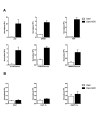DamIP: a novel method to identify DNA binding sites in vivo
- PMID: 20419059
- PMCID: PMC2858267
- DOI: 10.1621/nrs.08003
DamIP: a novel method to identify DNA binding sites in vivo
Abstract
Identifying binding sites and target genes of transcription factors is a major biologic problem. The most commonly used current technique, chromatin immunoprecipitation (ChIP), is dependent on a high quality antibody for each protein of interest, which is not always available, and is also cumbersome, involving sequential cross-linking and reversal of cross-linking. We have developed a novel strategy to study protein DNA binding sites in vivo, which we term DamIP. By tethering a mutant form of E. coli DNA adenine methyltransferase to the target protein, the fusion protein introduces N-6-adenosine methylation to sequences proximal to the protein binding sites. DNA fragments with this modification, which is absent in eukaryotes, are detected using an antibody directed against methylated adenosine. For an initial test of the method we used human estrogen receptor alpha (hERalpha), one of the best studied transcription factors. We found that expression of Dam-hERalpha fusion proteins in MCF-7 cells introduces adenosine methylation near a series of known direct hERalpha binding sites. Specific methylation tags are also found at indirect hERalpha binding sites, including both primary binding sites for the ER interactors AP-1 and SP1, and promoters that are activated by upstream ER bound enhancers. DamIP provides a new tool for the study of DNA interacting protein function in vivo.
Figures





Similar articles
-
Research resource: The estrogen receptor α cistrome defined by DamIP.Mol Endocrinol. 2012 Feb;26(2):349-57. doi: 10.1210/me.2011-1080. Epub 2011 Dec 29. Mol Endocrinol. 2012. PMID: 22207717 Free PMC article.
-
DamIP: using mutant DNA adenine methyltransferase to study DNA-protein interactions in vivo.Curr Protoc Mol Biol. 2011 Apr;Chapter 21:Unit21.21. doi: 10.1002/0471142727.mb2121s94. Curr Protoc Mol Biol. 2011. PMID: 21472695 Free PMC article.
-
ChIP-nexus enables improved detection of in vivo transcription factor binding footprints.Nat Biotechnol. 2015 Apr;33(4):395-401. doi: 10.1038/nbt.3121. Epub 2015 Mar 9. Nat Biotechnol. 2015. PMID: 25751057 Free PMC article.
-
DamID: mapping of in vivo protein-genome interactions using tethered DNA adenine methyltransferase.Methods Enzymol. 2006;410:342-59. doi: 10.1016/S0076-6879(06)10016-6. Methods Enzymol. 2006. PMID: 16938559 Review.
-
Transcriptional activation of genes by 17 beta-estradiol through estrogen receptor-Sp1 interactions.Vitam Horm. 2001;62:231-52. doi: 10.1016/s0083-6729(01)62006-5. Vitam Horm. 2001. PMID: 11345900 Review.
Cited by
-
DamID as a versatile tool for understanding gene regulation.Development. 2019 Mar 15;146(6):dev173666. doi: 10.1242/dev.173666. Development. 2019. PMID: 30877125 Free PMC article. Review.
-
CATaDa reveals global remodelling of chromatin accessibility during stem cell differentiation in vivo.Elife. 2018 Feb 26;7:e32341. doi: 10.7554/eLife.32341. Elife. 2018. PMID: 29481322 Free PMC article.
-
DNA Methylation.EcoSal Plus. 2014 May;6(1):10.1128/ecosalplus.ESP-0003-2013. doi: 10.1128/ecosalplus.ESP-0003-2013. EcoSal Plus. 2014. PMID: 26442938 Free PMC article.
-
Human MAF1 targets and represses active RNA polymerase III genes by preventing recruitment rather than inducing long-term transcriptional arrest.Genome Res. 2016 May;26(5):624-35. doi: 10.1101/gr.201400.115. Epub 2016 Mar 3. Genome Res. 2016. PMID: 26941251 Free PMC article.
-
Dam it's good! DamID profiling of protein-DNA interactions.Wiley Interdiscip Rev Dev Biol. 2016 Jan-Feb;5(1):25-37. doi: 10.1002/wdev.205. Epub 2015 Sep 18. Wiley Interdiscip Rev Dev Biol. 2016. PMID: 26383089 Free PMC article. Review.
References
-
- Barnett D. H., Sheng S., Charn T. H., Waheed A., Sly W. S., Lin C. Y., Liu E. T., Katzenellenbogen B. S. Estrogen receptor regulation of carbonic anhydrase XII through a distal enhancer in breast cancer. Cancer Res. 2008;68:3505–15. - PubMed
-
- Carroll J. S., Meyer C. A., Song J., Li W., Geistlinger T. R., Eeckhoute J., Brodsky A. S., Keeton E. K., Fertuck K. C., Hall G. F., Wang Q., Bekiranov S., Sementchenko V., Fox E. A., Silver P. A., Gingeras T. R., Liu X. S., Brown M. Genome-wide analysis of estrogen receptor binding sites. Nat Genet. 2006;38:1289–97. - PubMed
-
- Collas P. The State-of-the-Art of Chromatin Immunoprecipitation. Methods Mol Biol. 2009;567:1–25. - PubMed
Publication types
MeSH terms
Substances
Grants and funding
LinkOut - more resources
Full Text Sources
Other Literature Sources

